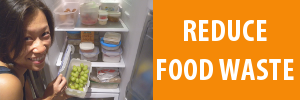Reducing food waste: Getting Singaporeans to embrace ‘ugly food’ [News]
October 24, 2016 by Save Food Cut Waste
Filed under Blog
By Liyana Othman, Channel NewsAsia, 24 Oct 2016
More than 790,000 tonnes of food waste was generated in Singapore last year – almost the equivalent of throwing away two bowls of rice every day.
There are no official figures on the breakdown of food waste in Singapore, and also how throwing away blemished or oddly-shaped food may contribute to the problem. But studies have shown that globally, 46 per cent of fruits and vegetables never make it from farm to fork.
Click here to read the full article
Source: Channel NewsAsia
Food waste gets second life as compost at international school [News]
October 14, 2016 by Save Food Cut Waste
Filed under Blog
By Lim Jia Qi, Channel NewsAsia, 12 Oct 2016
Vegetable peels, fruit waste and coffee grounds – all this organic waste does not simply go down the garbage chute at the Dover campus of the United World College of South East Asia (UWCSEA).
Instead, these are given a second life as compost for the school’s gardens. In 2012, UWCSEA started a composting project in a bid to reduce food wastage. Getting the project underway was not easy – it involved a few high school students setting up a composting site within the school and collecting pre-cooked waste such as vegetable peels and fruit scraps from the canteen daily.
Click here to read the full article
Source: Channel NewsAsia
Non-profit groups step up efforts to bring restaurant excess to needy [News]
October 14, 2016 by Save Food Cut Waste
Filed under Blog
By Wong Casandra, TODAY, 25 Sep 2016
Sometimes it’s lamb stew on the menu, other times it’s roast duck. For the past few months, Marina Bay Sands (MBS) has been donating excess food prepared for banquets to the less fortunate. On each occasion, an average of 50 to 80 trays of unserved, blast-frozen cooked dishes are delivered for same-day consumption.
Under the watchful eye of Executive Chef Christopher Christie, kitchen staff check the food is at -5°C to -10°C before packing them into thermal boxes. Staff from The Food Bank Singapore stand ready to load them into a van for delivery.
Click here to read the full article
Source: TODAY
Food waste: Where food matters, looks matter more [News]
February 17, 2016 by Save Food Cut Waste
Filed under Blog
By Channel NewsAsia, 16 Feb 2016
If you and your family made it a point to finish every morsel of your Chinese New Year meals, then you have all done exceptionally well.
This is because every year, Singapore sees hundreds of thousands of tonnes of food going to waste. According to the National Environment Agency, the country wasted approximately 790,000 tonnes of food in 2014. During the Chinese New Year period, food waste increases by up to 20 per cent.
As a small country with limited agricultural ability, Singapore is heavily reliant on imports for food. In 2014, Singapore spent US$10.6 billion (S$14.8 billion) importing 5.93 million tonnes of food. But out of that, 13 per cent of its imports, or US$1.4 billion worth of it, end up as waste.
Click here to read the full article
Source: Channel NewsAsia
2 hawker centres to pilot food waste recycling systems [News]
January 24, 2016 by Save Food Cut Waste
Filed under Blog
By Chan Luo Er, Channel NewsAsia, 21 Jan 2016
A two-year on-site food waste recycling pilot at two hawker centres, Ang Mo Kio Blk 628 Market and Tiong Bahru Market, was launched on Thursday (Jan 21).
The National Environment Agency (NEA) estimated that each market generates two to three tonnes of food waste daily, with the majority from stalls in the wet market and table cleaning operations. If the pilot is successful, food waste recycling could reduce the total waste generated from both hawker centres by up to 80 per cent, the agency said.
For instance, the machine at Ang Mo Kio Blk 628 Market, operated by Eco-Wiz, is able to convert one tonne of food waste into water within 24 hours. Customised microbes would break down food waste to convert it into water, and the water is then used for cleaning the bin centre.
Click here to read the full article
Source: Channel NewsAsia
Change practices to reduce food waste, urges Masagos [News]
January 11, 2016 by Save Food Cut Waste
Filed under Blog
By Neo Chai Chin, TODAY, 10 Jan 2016
In calling food waste one of the biggest streams of waste here, Minister for the Environment and Water Resources Masagos Zulkifli said all stakeholders have a role to play in managing this.
Some practices such as the culture of excess at banquets must change, “without totally changing the way we live as a community in Singapore”, he told reporters after the SGfuture dialogue “Moving Towards a Zero Waste Nation: Food Waste” led by his ministry today (Jan 10).
Reducing food waste is a way for households to save money, and Singaporeans should not take the amount of food available here for granted, he added.
Click here to read the full article
Source: TODAY
Singapore needs to rethink food wastage: Masagos [News]
January 11, 2016 by Save Food Cut Waste
Filed under Blog
By Liyana Othman, Channel NewsAsia, 10 Jan 2016
There is a need to rethink how to reduce, reuse and recycle food waste amid an increase over the years, said Minister for Environment and Water Resources Masagos Zulkifli on Sunday (Jan 10).
In 2014, Singapore generated around 790,000 tonnes of food waste, equivalent to two bowls of food per person each day. Only 13 per cent of that amount was recycled.
Over the past 10 years, the amount of food waste Singapore generates has increased by about 48 per cent, and the number is set to increase as the country continues to grow in terms of population and affluence.
Click here to read the full article
Source: Channel NewsAsia
More food outlets looking to reduce waste during festive season [News]
December 28, 2015 by Save Food Cut Waste
Filed under Blog
By Olivia Siong, Channel NewsAsia, 27 Dec 2015
During the festive season, food waste is expected to go up by about 10 to 20 per cent, according to the non-governmental organisation Zero Waste. Some organisations have been looking tackle the problem.
The increased waste comes from preparing more food during the festive season.
“I think if you organise a party during the festive season you might cook too much or order too much food,” explained Mr Eugene Tay, executive director of Zero Waste. “For F&B companies during the festive season, they might anticipate more crowd or customers, so they might prepare or cook more food.”
Click here to read the full article
Source: Channel NewsAsia
NEA to launch campaign to get people to cut food waste [News]
November 21, 2015 by Save Food Cut Waste
Filed under Blog
By Loke Kok Fai, Channel NewsAsia, 20 Nov 2015
The National Environment Agency (NEA) is launching a campaign next week to get people to cut food waste.
This comes on the back of a study by NEA and the Agri-Food and Veterinary Authority of Singapore (AVA) which showed that many people in Singapore are not comfortable with wasting food. However, the study also found that the biggest reason Singaporeans choose to cut down food waste is not to save the environment, but the pocket.
In 2014, consumers threw away 687,200 tonnes of food.
According to the study, eight in 10 respondents felt bothered about throwing away uneaten food, while 90 per cent of them felt that it was a waste of money. Concern for the environment “came a close second”, said NEA and AVA.
Click here to read the full article
Source: Channel NewsAsia
How do you solve a problem like food waste?
October 14, 2015 by Save Food Cut Waste
Filed under Blog
This article is contributed by Jean Chua.

Here are the staggering statistics: As much as one-third of food produced globally for our dining tables is lost or wasted, according to the World Bank.
Developing countries lose an average of 120 to 220 kilogrammes of food per person per year, which means that even those in regions ridden with malnutrition, such as South Asia and Sub-Saharan Africa, lose as many as 400 to 500 kilocalories per person, every day.
No matter how you look at it, that’s a lot of grub simply being thrown away. Food waste – when produce makes it to the end of the supply chain but doesn’t get eaten – is a huge problem that contributes to billions of tonnes of greenhouse gases (the chief culprit behind global warming) and needlessly consumes precious land and water resources. Read more








